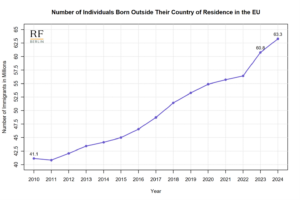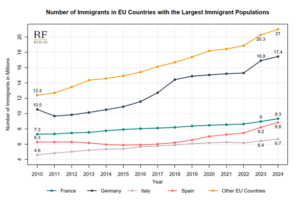Brussels – Over the past fifteen years, the percentage of foreign-born people living in Europe has increased significantly, driven by international crises such as conflict, climate change, and economic instability. However, this trend appears to be slowing in much of the old continent.
The latest Eurostat data, which the Rockwool Foundation Berlin (RFBerlin) analyzed, show that in 2024, net immigration increased significantly less than in 2023, with the percentage of immigrants (people not born in the Union) at 14.1 percent (2.5 million) of the total population compared with 13.6 percent (4.4 million people) in the previous year, or an increase of 0.5 percentage points, very slight when compared with 2022, when the flow of immigrants had doubled, from 2.5 to 5 million people. Everything seems to indicate that although more individuals from other continents are reaching Europe each year, the future trend may slow again, as data on irregular crossings and asylum applications to the European Union for the first months of 2025 already suggested.

Looking at the four biggest countries by immigrant population (Germany, France, Italy, and Spain), Spain led the way in new arrivals, with an increase of 630 thousand people, reaching 8.8 million. At the same time, Germany saw a rise between 2023 and 2024 of 500 thousand people (from 16.9 to 17.4 million). In France, there was a 360,000 people increase to 9.3 million, and in Italy, 260,000 people to 6.7 million. Tommaso Frattini, deputy director of RFBerlin’s migration unit and a professor at the University of Milan, pointed out that the increase in arrivals in France and Italy has remained almost “constant and modest” over the past fourteen years, fluctuating between 0.2 and 0.4 million people per year.

Source: Eurostat
The percentage of working-age immigrants (i.e., individuals between 15 and 64 years of age) as a proportion of the total population born abroad and residing in the EU has generally declined, from 81 percent in 2010 to 76 percent in 2024, with significant differences between countries. While the percentage of working-age people in Italy and Spain has remained stable at around 85 percent over the past fourteen years, Germany and France have seen the percentage drop by more than five percentage points over the same period.
Regarding refugees, 2024 represented a turning point, recording the first decline since 2019 (over 100 thousand fewer applications than the previous year). From 2010 to 2014, the number of first-time asylum seekers in the EU fluctuated at various times: after peaking at 1 million applicants in 2015, following the Syrian crisis, the number of applications gradually dropped to 600,000 in 2018, then rose again in 2022 and exceeded 1 million in 2023.
English version by the Translation Service of Withub






![[foto: European Council]](https://www.eunews.it/wp-content/uploads/2024/10/schengen-120x86.png)